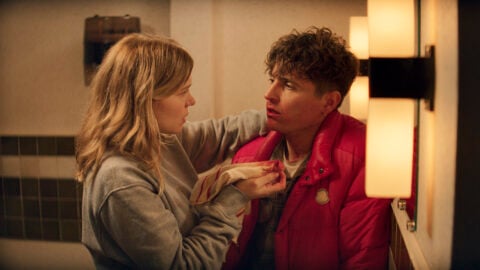Heaven Can Wait
 Image: Musee du Louvre. Courtesy of the Museum of Modern Art.
Image: Musee du Louvre. Courtesy of the Museum of Modern Art.
Early in Cinema Before 1300, Jerome Hiler’s feature-length survey of medieval stained glass, the filmmaker explains that he first saw Chartres Cathedral in the pages of a book gifted to him in the mid-1960s by Charles Boultenhouse and Parker Tyler, elders of the era’s New York avant-garde. It took another 25 years or so for Hiler to travel to Europe to see the cathedral for himself. He brought a Nikon to photograph stained glass across France and England, sharing his 35mm slides with friends and, eventually, in a few public lectures. After one such presentation at the Harvard Film Archive in 2017, Hiler was persuaded by HFA Director Haden Guest to turn his slides into the discursive film that will show at the Museum of Modern Art next week, ahead of several programs of his and his partner Nathaniel Dorsky’s lush experimental films.
It feels odd to call Cinema Before 1300 an essay film, since the term has come to be associated with a riddling, theory-minded style. Hiler’s approach is closer to the classical ideal of the essay: lucid, companionable, amateur in the original sense (as in, “one who loves”). He is perfectly willing to concede the limits of his knowledge—“I don’t know what the significance of that is,” he says of the recurring figure of a king tugging at his collar like “an ancestor of Rodney Dangerfield”—but his exploration is nevertheless grounded in years of close looking and practical know-how. (In addition to making intensely lyrical films, Hiler has worked extensively, if privately, with glass.)
For those who might demur at the prospect of an old-school art-history lecture, it ought to be said that Hiler’s photographs are totally gorgeous. His framing shows the windows to great advantage, and the saturated color of his original 35mm slides is a perfect match for the brilliance of the stained glass. The narration approaches this visual index from a variety of angles: with a theological gloss on Pseudo-Dionysius the Areopagite’s idea of “light from divine darkness,” for instance, or a historical note on the cataclysmic fire that ripped through Chartres in 1194. Hiler muses on how the windows change with weather and time of day, making “many windows out of one”; offers a technical explanation of the perceptual effects of halation; argues for leaving the marks of age in any restoration; and marvels at all the pictorial detail that couldn’t have been seen by congregants—just as, we might note, the subtleties of his own richly detailed films invariably escape a first viewing.
It is rather amazing that a work so full of information should also feel so serene. Similar to the way in which large stained-glass windows are made from many smaller pieces of glass, Hiler divides Cinema Before 1300 into discrete sequences, each comprising a paragraph’s worth of narration and a few slides of the glories of Chartres, Saint-Denis, Canterbury, and other cathedrals. At the end of each stanza, Hiler finishes his talk and pauses for a few beats, allowing the glass to have the last word, and then repairs to darkness. He uses interleaving blackouts to the same rhythmic, almost respiratory effect in his lyrical films, but here the technique doubles back to the imagined space of the cathedral. “Darkness is the sacred setting that film and stained glass share,” Hiler reflects over an extended interval of black toward the beginning of the film. “Our overview begins in the early 12th century, a time when darkness was imbued with a powerful spiritual significance . . . It was not the darkness of negation; it was pregnant, life-giving, limitless, and timeless.”
The connection between the cathedral and the cinema goes well beyond the shared spiritual interplay of light and dark: there is also the sequential nature of early narrative art; the saints as movie stars, with “personalities . . . known, loved, and adopted by the populace”; the way the likeness of a window’s sponsor functioned like an executive-producer credit; and how certain tropes, like the devil perched on a person’s shoulder, have passed through time virtually unchanged. Leaving narrative aside, Hiler can’t resist mentioning how five densely patterned windows at York Minster resemble Stan Brakhage filmstrips, and we might just as easily see the mandala-minded Harry Smith in the alchemist’s rose at Notre-Dame or the 3D-obsessed Ken Jacobs in the frequently used blues and reds that produce a mesmerizing sense of “dimension without perspective.” Perhaps most salient is the medieval ideal of claritas, which, per Hiler, creates “an environment that [awakens] the mind through the senses”—very close indeed to the “devotional cinema” explored in Dorsky’s slim book of the same name.
In this telling, the first “death of cinema” can be dated back to 1241, when a Council of the Sorbonne ruling indirectly led to clear windows flooding cathedrals with daylight, banishing the necessary conditions for stained glass to work its magic. The fate of the cathedrals readily brings to mind the devolution of the great movie palaces, including, in just the past year, the Castro Theatre in San Francisco, Hiler and Dorsky’s longtime hometown. More particular to Hiler’s own craft, the historical subject also lends itself to thinking about what it means to stay true to an artistic lineage when the tide goes out. Hiler’s lament, late in Cinema Before 1300, that he watches his “world of culture and values disappear in daily installments” needs to be taken alongside the film’s testament to the remarkable persistence of material culture even through the most trying circumstances.
In a long interview included in the recent book Illuminated Hours: The Early Cinema of Nathaniel Dorsky and Jerome Hiler, Hiler recalls that his very first shot with a movie camera was of a rose-colored piece of glass. A friend advised that instead of actually filming stained glass, Hiler should make his films themselves “be like stained glass.” Viewers can judge his success in the upcoming programs celebrating the book at MoMA and Anthology Film Archives, but Cinema Before 1300, like Hiler’s earlier documentary work, stands on its own two feet. A few weeks after watching the film at home, I went up to the Cloisters on a rainy day and found the stained-glass figures in the Early Gothic Room waiting for me, perfectly assured yet surprisingly familiar. Which is to say that Cinema Before 1300 leaves a long-lived afterimage—and its own measure of sanctuary.
Max Goldberg is an archivist and writer based in the Boston area.







